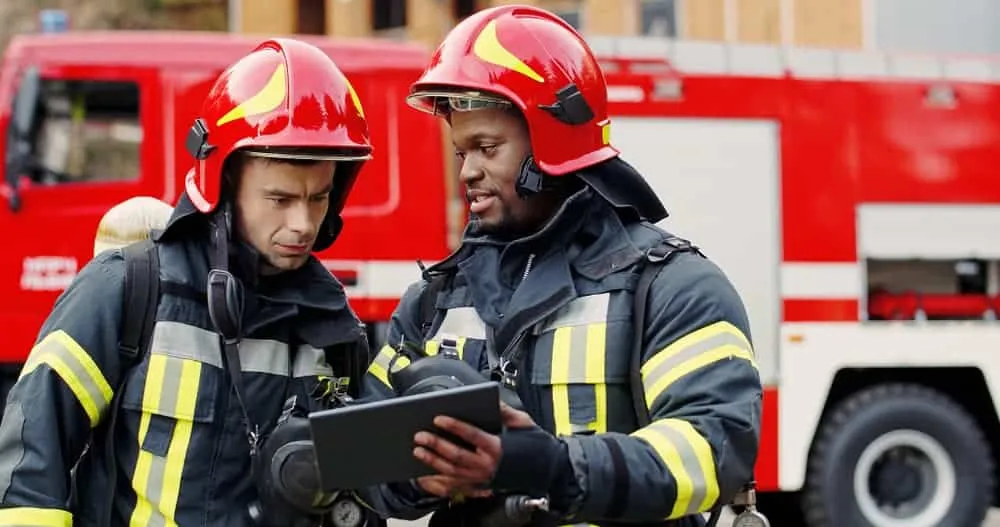When one thinks of a firefighter, a fearless individual wrapped in a hazmat-like suit directing their sprinkler pipe towards a blazing flame is what comes to mind. We know these societal bulwarks by their signature red trucks, loud sirens, and extendable ladders.
However, did you know that firefighters do a lot more than suppressing fires? They also rescue people trapped in buildings, natural disaster sites, etc. Additionally, they respond to medical emergencies, carry out station tours, and enforce public safety codes.
According to the National Fire Department Registry, over one million firefighters work in registered fire departments across the US. Frequently handling life-and-death situations, firefighters are nothing short of heroes. However, not many people understand the hidden costs involved in being one.
This article discusses the hazards and risks that firefighters take to ensure others are safe.
Physical Hazards
A typical firefighter finds themselves running towards a scene others are fleeing from. Despite wearing protective gear like helmets, boots, bunker gear, goggles, etc., there are physical risks involved. We are not just talking about being burned (though that may be the greatest risk of all).
Firefighters sometimes expose themselves to deadly levels of carbon monoxide (CO) and other chemicals. Another major example would be Per- and Polyfluoroalkyl Substances (PFAS) found in Class B firefighting foams or Aqueous Film-Forming Foams.
The physical and chemical hazards are often deadly. Listed below are three health conditions firefighters are most susceptible to suffering from –
Table of Contents
1. Heart Disease
A descriptive study conducted on Cape Town’s firefighters found that at least 45% of fatalities resulted from sudden cardiac arrest. However, heart disease risk is the greatest among firefighters who smoke, are overweight or do not lead a healthy lifestyle.
Firefighters work under highly stressful conditions where oxygen levels are low, the environment is torrid, and the pressure is intense. Amidst all this chaos, breathing in too much CO can easily cause the heart to fail. Abnormal heartbeat and coronary heart disease become inevitable in such cases.
Since poor sleep is a major contributor to heart disease, fire departments should ensure every firefighter enjoys a balanced work schedule.
2.Cancer
Firefighters are exposed to a host of hazardous carcinogenic substances on a daily basis. According to the Centers for Disease Control (CDC), cancer is a leading cause of death among firefighters. The risks are even higher where Class B firefighting foams containing Per- and Polyfluoroalkyl Substances (PFAS) are used.
PFAS contain Perfluorooctanoic Acid (PFOA) and Perfluorooctanesulfonic Acid (PFOS), two dangerous synthetic chemicals. Out of these, PFOA is extensively studied and was deemed carcinogenic by the International Agency for Cancer Research (IACR).
Firefighting foam cancer cases have included those involving the kidneys, liver, testicles, pancreas, breast, blood, and bladder. The US Fire Administration reveals that firefighters are at a 14% higher risk of cancer-related death compared to the general masses.
Given the health hazards associated with AFFFs, firefighters have filed hundreds of lawsuits against manufacturers like 3M, DuPont, etc. According to TorHoerman Law, AFFFs are gradually being replaced by fire suppressants that do not contain toxic chemicals. However, the former’s use is reserved for extreme situations.
Companies like 3M have even announced that they will stop AFFF production by the end of 2025. Laws banning AFFFs are being enforced throughout the world.
3. Chronic Respiratory/Pulmonary Disease
The most common chemicals found in smoke include nitrogen dioxide and carbon monoxide. Breathing huge volumes of CO drastically reduces the oxygen levels of the body. This inorganic compound is largely produced during the knockdown or first phase of a firefighting intervention.
Since firefighters are vulnerable to inhaling CO (regardless of a self-contained breathing apparatus), they may develop lung disease. A meta-analysis study discovered that lung damage also depended on the firefighter’s age and smoking habits.
Another study concluded that chronic obstructive pulmonary disease (COPD) was associated with a disastrous event rather than the occupation itself. In any case, inhaled therapy was shown to help in patient recovery.
Furthermore, fire departments must use mitigation strategies like alternating firefighters appointed for heavy-smoke situations. This combined with proper training and medical surveillance programs should reduce instances of pulmonary disorders.
Psychological Risks
Though much is studied about the physical and chemical hazards of firefighting, less is known about the occupation’s psychological risks. The National Library of Medicine published a systemic review studying the psychological stressors among firefighters.
The health outcomes were divided into six categories, including –
- Depression-suicidal tendencies
- Non-depressive mental health like anxiety
- Substance abuse disorders
- Poor sleep quality
- Burnout
- Somatic disorders
It was found that firefighters suffer from the above-mentioned mental health issues, depending on their work culture and organizational fairness. Sleep issues were only found in cases where firefighters were already battling depression and work-related stress.
Such studies are vital because high levels of stress are closely tied to cardiac issues. Fire departments must run regular mental health checks and gather feedback on working conditions.
Thermal Hazards
The thermal or heat-related health hazards of firefighting need a separate section as they impact both physical and psychological health. A recent incident was the Nevada wildfire that broke out due to a helicopter crash. Two volunteer firefighters suffered second and third-degree burns trying to save the crash victims.
This was a unique case where both firefighters were not wearing protective gear, given the circumstances of the rescue mission. An average Nomex firefighting service suit can withstand up to 700◦ F, beyond which it quickly degrades.
In some cases (especially jet fuel fires), the temperatures can rise to a whopping 2500◦ F. If the firefighter needs to enter the burning scene to save lives, they risk incurring severe thermal burns. Then, there’s also the problem of steam burns.
Steam burns usually occur when the air layer between the skin and the firefighting suit gets heated up. A study found that heat-related illness among firefighters included symptoms like dizziness, sudden muscle cramps, confusion, fainting, and vomiting.
Of the firefighters surveyed in the study, 74.8% agreed to experiencing at least one symptom of heat-related illness. Depending upon the severity of the burns or the incident, firefighters also suffer from Post-Traumatic Stress Disorder (PTSD). The gradual change in health post-burn can lead to anxiety and depression.
Unsung Heroes of the Modern Age
Recent natural disasters like California’s raging wildfires and the ravaging earthquake in Turkey have shown firefighters for who they are – heroes wearing protective gear. According to the US Fire Administration, there have already been 49 firefighter fatalities in 2023.
On May 7th, 2023, bells rang across America to commemorate the lives of brave firefighters lost in previous years. It was organized by the National Fallen Firefighters Foundation as a part of the National Fallen Firefighters Memorial Weekend. Also, fire departments and homes were lit up red from May 4th to 7th.
Be it the somber crisis of 9/11 or the horrifying disaster at Chernobyl, firefighters have proven that they would run towards certain death if it meant saving others’ lives. They truly are the unsung heroes of the Modern Age!









